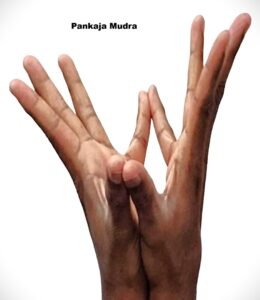Pankaja Mudra
Introduction
Pankaja Mudra is a symbolic hand gesture used in yoga and meditation practices. The word Pankaja means “lotus” in Sanskrit (panka = mud/slush, ja = born). Just like a lotus blooms beautifully out of muddy water, this mudra symbolizes purity, spiritual awakening, and rising above worldly obstacles. It is often practiced in meditation to open the heart, enhance compassion, and deepen connection with higher consciousness.
Meaning
Pankaja = Lotus
Symbolizes spiritual growth, purity, resilience, and transcendence.
Represents the unfolding of inner wisdom and the blossoming of consciousness.
Associated with the heart (Anahata) chakra and sometimes with the crown (Sahasrara) chakra.
How to Perform / Practice
Sit comfortably in Padmasana (Lotus Pose), Sukhasana (Easy Pose), or any meditative posture.
Bring both palms together in Namaskar Mudra (Anjali Mudra) at the chest level.
Keeping the base of the palms and little fingers together, spread and open the other fingers outward.
The shape formed resembles a blossomed lotus flower.
Rest the mudra at the level of the heart (chest) or in front of the navel.
Close the eyes, relax the shoulders, and breathe deeply.
Focus on the lotus symbol, visualize a blooming lotus at the heart center.
Practice for 5–15 minutes daily or as part of meditation and pranayama.
Benefits
Opens and activates the heart chakra.
Promotes compassion, love, and emotional healing.
Enhances meditation and spiritual awareness.
Reduces stress, anxiety, and emotional blockages.
Encourages purity of thoughts and resilience.
Balances energy flow in the chest and respiratory system.
Symbolically connects practitioner to divine consciousness.
Contraindications
Not recommended for people with severe shoulder, wrist, or finger injuries.
Those with extreme emotional trauma may feel overwhelmed—should practice under guidance.
Avoid if it causes physical strain in fingers/joints.
Anatomy & Physiology
Activates muscles of the palms, fingers, forearms.
Opens the chest cavity, encouraging better lung expansion.
Stimulates cardiac and respiratory functions.
Energetically stimulates the parasympathetic nervous system (calm response).
Kinesiology
Involves extension and abduction of fingers.
Engages intrinsic hand muscles (lumbricals, interossei).
Requires stabilization of wrists and finger joints.
Promotes balance between muscular expansion (openness) and stability.
Neurology
Stimulates sensory and motor nerves of the hand (median and ulnar nerves).
Creates calming feedback loops via vagus nerve activation.
Enhances neuroplasticity by associating symbolic gestures with emotional states.
Duration of Practice
Beginners: 5 minutes daily.
Intermediate: 10–15 minutes in meditation.
Can be practiced longer during mantra chanting or pranayama sessions.
Counter Mudra
Hridaya Mudra (Heart Gesture) – balances emotions.
Anjali Mudra (Prayer Gesture) – grounding alternative.
Padma Mudra is very similar but used more often; Pankaja is its symbolic variation.
Conclusion
Pankaja Mudra is a gesture of purity, resilience, and inner awakening. By resembling the lotus flower, it reminds practitioners to remain pure and strong while rising above worldly negativity. Practiced regularly, it helps open the heart chakra, enhance compassion, and deepen spiritual awareness.
FAQ
Q1. Is Pankaja Mudra the same as Padma Mudra?
No. Both symbolize a lotus, but Padma Mudra is more widely recognized. Pankaja Mudra is a traditional variation used in certain schools of yoga and rituals.
Q2. When should I practice Pankaja Mudra?
Best during meditation, mantra chanting, or heart-centered pranayama practices.
Q3. Can beginners practice it daily?
Yes, but start with short durations (3–5 minutes).
Q4. Does it help with stress?
Yes, it calms the mind and helps emotional balance.
References
Saraswati, Swami Satyananda. Asana Pranayama Mudra Bandha.
Gertrud Hirschi. Mudras: Yoga in Your Hands.
Hatha Yoga Pradipika & Gheranda Samhita (classical references to lotus symbolism).
Tiwari, O.P. Pranayama: The Breath of Yoga.

